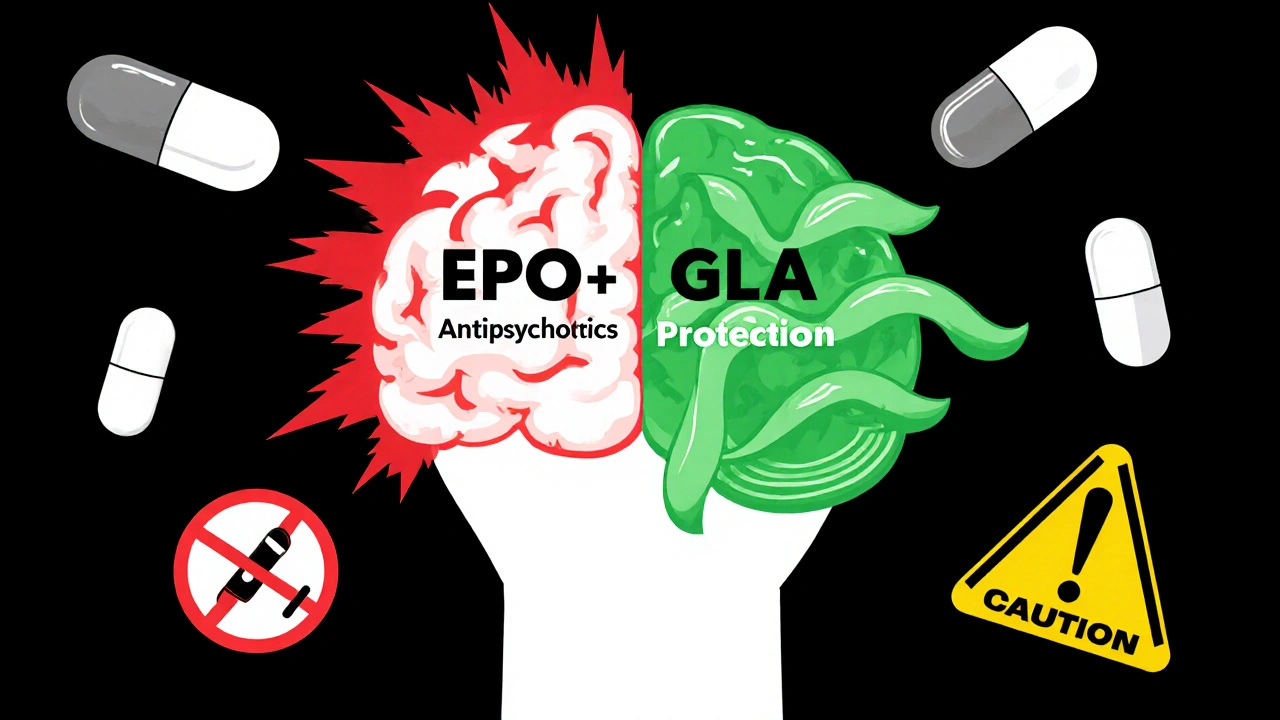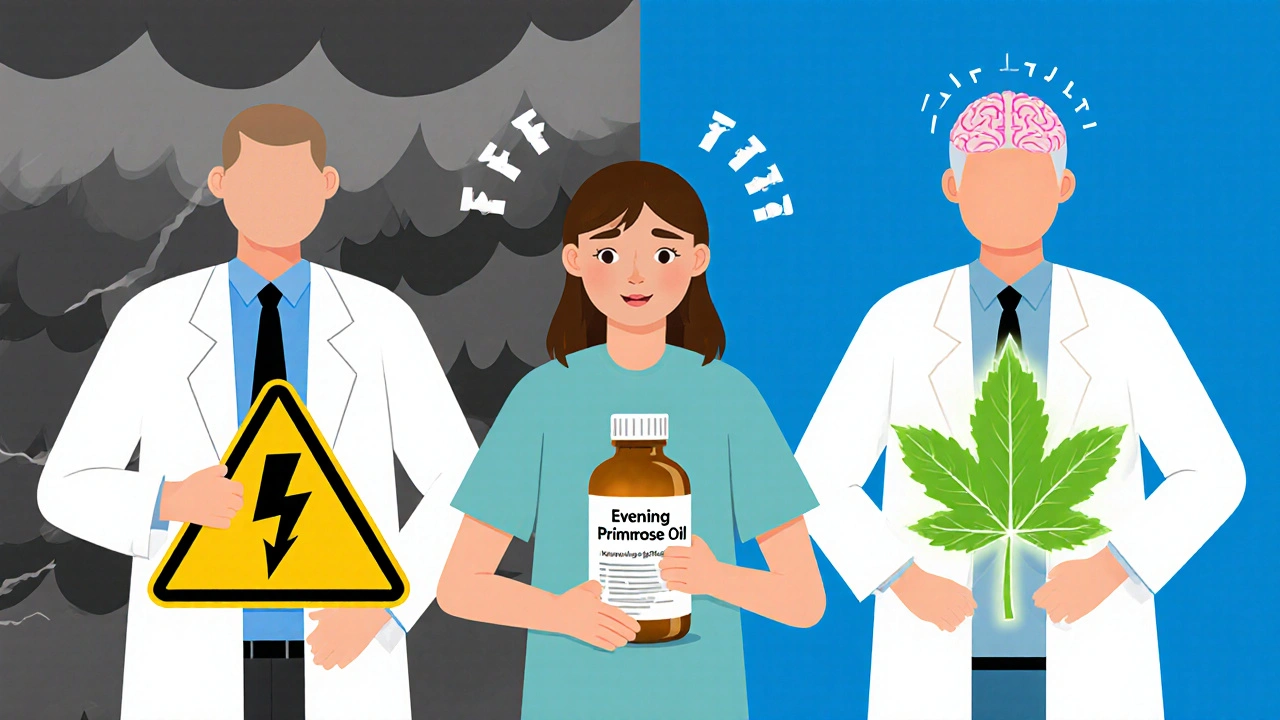EPO-Antipsychotic Risk Assessment Tool
Assess Your Individual Risk
This tool helps you understand the potential seizure risk when taking evening primrose oil with your antipsychotic medication based on current medical evidence.
If you're taking antipsychotic medication and considering evening primrose oil (EPO) for PMS, eczema, or joint pain, you're not alone. But you might be walking into a medical gray zone with real risks. Some doctors say it's safe. Others say it could trigger seizures. And the science? It’s split right down the middle.
What Is Evening Primrose Oil?
Evening primrose oil comes from the seeds of the evening primrose plant, a wildflower native to North America. It’s packed with omega-6 fatty acids-mostly linoleic acid (74%) and gamma-linolenic acid (GLA, about 9%). GLA is the part that gets converted in your body into prostaglandin E1, a compound with anti-inflammatory effects. That’s why people take it-for things like breast pain, dry skin, and rheumatoid arthritis.
It’s sold as softgels, usually 500mg to 1,300mg per capsule. You take it orally, and it hits your bloodstream in about 2.7 to 4.4 hours, depending on whether you take it in the morning or evening. Sounds harmless, right? But here’s where things get complicated.
The Seizure Controversy: Two Sides of the Same Coin
The fear around EPO and seizures started in the 1980s with a few case reports. One person had a seizure after taking EPO. Then another. Then another. Doctors panicked. By the 1990s, warnings popped up on labels and in medical guides: Don’t take this if you have epilepsy.
But in 2007, Dr. BK Puri from Imperial College London dug into the data. He looked at every study, every case report, every animal model. And he found something surprising: the evidence didn’t hold up. In fact, in controlled rat studies, EPO components actually protected against seizures. He showed that GLA and linoleic acid can block sodium channels in brain cells-something many anti-seizure drugs do. Prostaglandin E1, derived from GLA, also has documented anticonvulsant activity.
Puri concluded the seizure link was spurious. He argued that guidelines should remove EPO from the list of seizure-triggering supplements.
But here’s the twist: most major health institutions didn’t listen.
Why Do Mayo Clinic and Walgreens Still Warn Against It?
As of 2023, Mayo Clinic’s official stance is clear: Don’t take evening primrose oil if you have epilepsy or schizophrenia. It might raise your risk of seizures. Walgreens’ medication guide says the same thing. Familiprix, a Canadian pharmacy chain, warns that EPO can increase seizure frequency when taken with antipsychotics like flupentixol (Fluanxol) and chlorpromazine (Largactil).
Why the disconnect? Because medicine doesn’t move on facts alone-it moves on risk.
Even if only one person out of 1,000 has a bad reaction, and that reaction is a seizure, hospitals and pharmacies err on the side of caution. Case reports, even if rare, stick. One patient on quetiapine started having seizures after starting EPO. Their neurologist blamed the supplement. The family stopped it. The seizures stopped. That’s powerful anecdotal evidence.
And it’s not just epilepsy. Antipsychotics themselves can lower the seizure threshold. Drugs like clozapine, olanzapine, and even newer ones like brexpiprazole and lumateperone are known to carry this risk. Add EPO into the mix, and you’ve got two potential triggers working together.
DrugBank, updated in April 2025, now lists five antipsychotics with documented interaction risks: amifampridine, flupentixol, chlorpromazine, brexpiprazole, and pimavanserin. That’s not a small list.

What Does the Science Actually Say?
Let’s break down the evidence levels:
- Class IV (lowest) evidence - The American Academy of Neurology says the link between EPO and seizures is based on weak, observational data. No large, controlled trials prove it causes seizures.
- Animal studies - Show EPO may protect against seizures, not cause them.
- Human case reports - Do exist, but often involve other drugs, alcohol, sleep deprivation, or missed antiepileptic doses. Was EPO the real culprit?
- 2024 clinical trial - A major study (NCT05678901) is currently underway, tracking 300 epilepsy patients on EPO over 18 months. Results won’t be out until 2026.
So here’s the truth: we don’t have a definitive answer. We have conflicting reports, plausible mechanisms, and a lot of uncertainty.
What Do Real People Experience?
Surveys of patients tell another story. On Drugs.com, Sarah K., an epilepsy patient, says she’s taken EPO for PMS for two years with no change in seizure frequency. On Reddit’s r/Epilepsy, 57% of 142 respondents said they used EPO without issues. But 32% said their seizures got worse-especially when combining it with quetiapine or olanzapine.
On HealthUnlocked, a forum for people with epilepsy, 15 out of 43 users reported increased seizures after starting EPO. Nine said they couldn’t tell if it was the supplement or something else. The rest saw no effect.
WebMD’s 1,842 reviews give EPO a 3.2 out of 5 for safety in neurological conditions. That’s not great-but it’s not terrible either. It means half the people who tried it had no problem. The other half? They either had a bad reaction or were too scared to keep going.

Who Should Avoid Evening Primrose Oil?
Here’s the practical advice based on current evidence:
- Avoid EPO if: You have epilepsy, schizophrenia, or a history of seizures-even if they’re well-controlled.
- Be extra cautious if: You’re on antipsychotics like clozapine, olanzapine, quetiapine, flupentixol, chlorpromazine, brexpiprazole, lumateperone, or pimavanserin.
- Don’t combine EPO with: Other supplements that lower seizure threshold, like borage oil, ginkgo biloba, or high-dose fish oil.
- Watch for: New or worsening seizures, unusual muscle twitching, confusion, or loss of awareness after starting EPO.
If you’re on antipsychotics and want to try EPO for PMS or skin issues, talk to your psychiatrist or neurologist first. Don’t just buy it off the shelf and assume it’s safe.
What Are the Alternatives?
If you need relief from PMS, eczema, or inflammation without risking seizures, here are safer options:
- For PMS: Calcium (1,200mg/day), vitamin B6 (50-100mg/day), or magnesium (360mg/day)-all have strong evidence and no seizure risk.
- For eczema: Topical ceramide creams, oatmeal baths, or moisturizers with shea butter. Oral omega-3s (fish oil) may help too, and they don’t carry the same seizure concerns.
- For inflammation: Turmeric (curcumin), ginger, or a Mediterranean diet. These have proven anti-inflammatory effects without neurological risks.
None of these alternatives have the same controversy as EPO. And they’re backed by stronger, safer data.
What’s Next?
The NIH has poured $2.3 million into research on EPO and seizures. The 2024 clinical trial could finally settle this debate. Until then, we’re stuck in limbo.
Supplement manufacturers know this. As of Q1 2024, 68% of EPO products carry epilepsy warnings on the label. But the warnings vary. Some say "may increase risk." Others say "contraindicated." Some don’t mention it at all.
And sales? They’re still rising. The global EPO market hit $187.5 million in 2023. People are still buying it. Many are still using it. But if you’re on antipsychotics or have epilepsy, you’re not just taking a supplement-you’re playing Russian roulette with your brain.
Don’t rely on anecdotal stories. Don’t assume "natural" means safe. And don’t ignore your doctor’s warning just because someone on Reddit said it was fine.
The truth? We need more data. But until we get it, caution isn’t overreaction-it’s survival.
Can evening primrose oil cause seizures in people taking antipsychotics?
Yes, there are documented cases where evening primrose oil (EPO) has been linked to increased seizure risk in people taking certain antipsychotics like quetiapine, chlorpromazine, and flupentixol. While the scientific evidence isn’t conclusive, multiple medical sources-including Mayo Clinic, DrugBank, and Familiprix-warn against combining EPO with these medications. The risk appears higher when multiple seizure-lowering agents are used together.
Is evening primrose oil safe for people with epilepsy?
Major health organizations like Mayo Clinic and the Epilepsy Foundation advise against it due to theoretical and anecdotal risks. However, a 2007 review by Dr. BK Puri found no evidence that EPO causes seizures and even suggested it may have protective effects. Until new clinical data is available (expected in 2026), most neurologists recommend avoiding EPO if you have epilepsy-even if your seizures are well-controlled.
What supplements should I avoid with antipsychotics?
Avoid supplements that lower the seizure threshold, including evening primrose oil, borage oil, ginkgo biloba, high-dose fish oil, and St. John’s wort. Some herbal products can also interfere with how antipsychotics are metabolized in the liver, leading to dangerous side effects. Always check with your prescriber before adding any supplement to your regimen.
Are there safer alternatives to evening primrose oil for PMS or eczema?
Yes. For PMS, calcium, magnesium, and vitamin B6 are well-studied and safe alternatives. For eczema, ceramide-based moisturizers, oatmeal baths, and topical steroids (when needed) are more reliable. Omega-3 fatty acids from fish oil may help with inflammation without increasing seizure risk. These options have stronger safety profiles, especially for people with neurological conditions.
Why do some sources say EPO is safe while others say it’s dangerous?
It comes down to how evidence is interpreted. Researchers like Dr. Puri focus on controlled studies and biological mechanisms, which suggest EPO may protect against seizures. Hospitals and pharmacies focus on real-world case reports and patient safety, where even one seizure triggered by a supplement is too many. Until large-scale human trials are complete, this gap will remain-and caution is the default recommendation.


Tyler Wolfe
October 29, 2025 AT 12:51i just started taking epo for my eczema and im on olanzapine. i didnt know about this risk until i saw this post. kinda freaked me out but im gonna talk to my dr before continuing. thanks for sharing.
Neil Mason
October 29, 2025 AT 20:37man canada just put warnings on everything these days. i took epo for years with quetiapine and never had an issue. my neurologist even said the data is weak. but yeah i get it they dont wanna get sued
Andrea Gracis
October 31, 2025 AT 02:09so wait so epo might actually help with seizures not cause them? that sounds crazy but also makes sense. why do they still warn people then? i feel like medicine is so confusing sometimes
Matthew Wilson Thorne
November 1, 2025 AT 21:17the 2007 paper was elegant. the current guidelines are performative risk management.
April Liu
November 1, 2025 AT 21:31hey everyone, i just wanted to say you’re not alone in feeling confused about this! i’m a nurse and i’ve seen both sides - some people swear epo helped their PMS, others had scary seizures. the safest move is always to check with your prescriber. no shame in asking! 💪❤️
Emily Gibson
November 2, 2025 AT 13:08im so glad this post exists. i was about to start epo for my dry skin and i have schizophrenia. i was gonna just try it since it's 'natural' but now i'm gonna hold off and talk to my psych. thank you for laying out the facts so clearly. you saved me from a bad decision.
Mirian Ramirez
November 3, 2025 AT 03:03okay so i read all of this and i think the real issue is that doctors are scared to change guidelines even when new science comes out. i mean dr puri’s review was solid and yet mayo clinic still says don’t take it? that’s not science, that’s liability. also i’ve been taking epo for 5 years with lithium and never had a seizure, but my cousin had one after starting it with clozapine - so maybe it’s not the supplement, maybe it’s the combo? and why do they never test the combos properly? they just slap warnings on everything and call it a day. also typo: its not 'epo' its 'evening primrose oil' but i get it lol
Kika Armata
November 3, 2025 AT 07:29It’s frankly embarrassing how the medical establishment still clings to anecdotal case reports like they’re peer-reviewed meta-analyses. The fact that DrugBank lists five antipsychotics as 'interacting' with EPO without any pharmacokinetic data is laughable. You’d think after 17 years of Dr. Puri’s work, someone with a PhD would have updated the guidelines. Instead, we get pharmacy chains parroting fear-based marketing copy. This isn’t medicine - it’s corporate risk aversion dressed up as patient care. And yes, I’ve read the 2024 trial protocol. It’s underpowered. They’ll need at least 1,200 subjects to detect a signal this subtle. But no, they’re not doing that. Because funding goes to pharmaceuticals, not to debunking supplement myths. The system is broken.